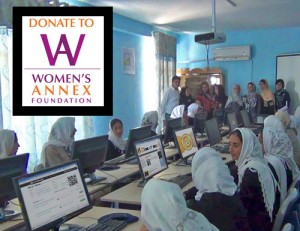Last month I was invited to the Peace Convention hosted by the American Muslim Voice Foundation to appear on an interfaith panel on income inequality, and it has taken me about a month to collect my thoughts about what was said. I don’t think about economics I those terms, primarily because actual equality in income would require incredible violence to establish and would disappear the moment someone made a purchase. None the less, I prefer not to shy away from any opportunity to discuss Bitcoin with general audiences. I was perturbed to discover that there was no economists on the panel. Only interfaith leaders and politicians. How did they neglect to invite an economist when the topic was income? So, once again, I was forced by circumstance to serve as the amateur economist in the room.
In my introduction I described my work at Bitcoin Not Bombs and the revolutionary power of Bitcoin. For the first time in history it is possible for the citizens of aggressive nations to donate to the relief efforts in the countries their government bombs. And it is possible for the civilians in terrorized nations to donate to the anti-war movement in the country that’s bombing them. And there’s nothing governments can do to stop it, because Bitcoin can move free and unmolested anywhere the Internet touches. There’s an old saying, “If goods don’t cross borders soldiers will.” That’s why economic sanctions are consisted an act of war. It’s nearly impossible to sustain an active war between nations that trade with one another. Well, if aggressive nations are unable to prevent trade, was will become increasingly difficult to sustain, and eventually impossible, because the people will not tolerate their governments bombing their trade partners. That’s why I’m most excited about Bitcoin. It treats national boundaries like the imaginary lines that they are.
Bitcoin also has huge potential for starving the so-called 1% and the upper quintile of income disparity graphs because it makes most of the financial services industry obsolete. No longer will we need banks to secure our savings. No longer will we need credit cards or PayPal to shop online. Bitcoin does all that, and with minimal development it can be made to do much more. Bitcoin creates fantastic opportunities for enterprising entrepreneurs from the lower income quintile to compete in a global marketplace with virtually no barrier to entry, making it incredibly disruptive to the economic status quo.
While I was excitedly bombastic about Bitcoin’s capacity to circumvent existing systems, most of the other panelists were primarily advocating political remedies for income inequality. One panelist seriously suggested nationalizing all robotics so that greedy capitalists couldn’t destroy jobs by automating manufacturing. Unfortunately the panel had far more panelists than time, and I wasn’t able to comment on most audience questions. Here’s what I would have said.
Of major concern to the audience and panelists alike was the issue of a living wage, and there was a general consensus that minimum wage, perhaps even a guaranteed minimum income, should be about $15 or the equivalent salary. What is seldom understood in such discussions is that a minimum wage, or really anything measured in dollars, is a floating standard. Consider this. In 1964 the minimum wage was $1.25. Today minimum wage is $8. If you had a choice between the minimum wage of 2013 or the minimum wage of 1964, you’d probably take the $8. But in 1964 US coins were made of silver, and the melt value of five silver quarters is about $20 today. So, $8 today actually purchases less than $1.25 did in 1964, despite the statutory trend always being to raise the minimum wage. We don’t have a wage problem. We have a currency problem.
I have heard it said over and over that people are willing to pay higher prices if it means that employees are earning a living wage. But if companies raise prices there is no guarantee what portion of that increase will go toward wages. And if wages are raised directly, through legislation, there is no guarantee that the jobs won’t simply disappear. For example, I’m sure you’re familiar with workers who stand on street corners with giant plastic arrows advertising mattress sales, or great deals on used cars. That’s about as unskilled as entry level work gets, and I can’t imagine them earning more then the legal minimum. But I’ve started to see them being replaced by mannequins with automated robotic arms. If you raise the price of labor beyond its value to a company, the job goes away. Plain and simple. What this requires is a culture change. Similar to Restaurants, if people are willing to pay higher prices for living wages, they should adopt a custom of retail tipping. Food servers in restaurants rarely make a living wage from the employer, but there is great demand for those jobs because so much is made in tips. There is no reason a custom of tipping other service jobs couldn’t be adopted.
Another major concern to the audience was education, and it’s impact on income inequality. The problem with education is two fold. First, students are not receiving a quality education from public schools. And second, college graduates who have done as their told their whole lives, checked all the right boxes and filling all the right circles come to the end of their college education and can’t find a job that pays them enough to get out of debt. The proposed solution to this was to remove funding from prisons and funnel that money into education, but this is an incredibly short sighted plan. First off, you can’t just defund prisons. If you do, you’ll end up with torture conditions similar to those found in Maricopa County under Sheriff Joe Arpaio, in which prisoners are fed green bologna and housed in tents in the Arizona heat. I didn’t get a chance to say so, but if the goal is to reduce the size and budget of American prisons, I would start by repealing all victimless crimes, and releasing all non-violent convicts. Reduce the need and the budget will follow. Reducing the budget without reducing the need is dangerous and irresponsible. But the problem with education isn’t a lack of funds anyway. The problem is uniformity. This may sound harsh, but it’s an immutable economic law. If you increase the supply of something you reduce the demand. So long as public schools and universities are increasing the supply of similarly qualified people, the demand for those qualifications, and therefor their potential earnings, will decrease. The more sausages you push through the factory by government subsidies the less valuable sausages will be.
Government cannot solve this problem, because government by it’s nature is centralized, and promotes standardization and uniformity. We need to diversify education, which means we need to liberalize it, and that will require a dramatic cultural change. Young people need to resist being funneled into the meat grinder and seek alternative forms of education. They need to be more entrepreneurial and less willing to just check the right boxes. Because a predictable box checker is interchangeable, and therefor disposable. Similarly, employers need to look more closely at an applicants actual qualities, regardless of how they were educated and what receipts they have for that education. In other words, all actors in the economy need to be individuated, and we need to stop using degrees as shortcuts for skill assessment.
The cornerstone of the discussion about income inequality is these various graphs of national income which show that over time the rich get richer and the poor get poorer. They are usually broken into five quintiles and the bottom fifth is shown earning less income over time, while the top fifth earns more over time. What’s misleading about these graphs is that they follow the income brackets, not the people in the income brackets. If you followed the individuals instead of the classes you would see a great ocean current where some individuals stay in their quintile, while others climb to great heights, and other fall from their lofty towers. In fact, if you analyze the individuals in aggregate the rich get richer and the poor get richer to, but the bottom income bracket always includes new comers to the economy, like those fresh graduates that can’t find the job they hoped to, but have great earning potential in the future. But regardless of the mobility within the income brackets we still see this trend where the money collects disproportionately at the top of the graph. Well, if it’s not the individuals themselves who perpetually get richer, than it is a systemic feature, not the symptom of individual greed. Well why would that be?
If you see a problem which permeates every corner of the economy, and does not have a clear source, but instead casts a shadow over everything, the first place you should look is the primary financial instrument, not any individual economic actor. As I said before. We have a currency problem, not a wage problem. The reason wealth collects at the top of the graph, regardless of the individuals who actually populate that class, is because the money is poured in the top of the graph when it’s created. New money is created by the Federal Reserve, spent into the economy in the form of government subsidies and bailouts, or dumped directly into the banking system. The financial services industry are like pigs gathered at the trough where the money is poured. Income inequality, at least to the degree that we see it now, is not a market function. Poverty is a necessary outcome, a systemic feature, of any monetary system where money is created from nothing and given to the politically connected first.











